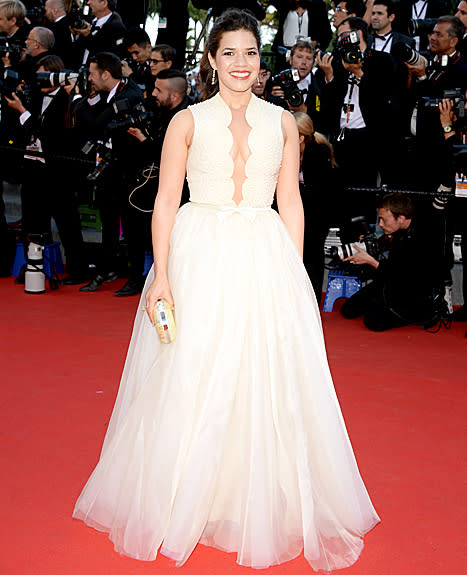For the past few years I've been using the same drugstore eyeliner - this one, by Almay:
It is perfectly serviceable. It does its job. It stays on (although not too long). And it is fairly easy to apply although creating identical lines in both eyes is somewhat of a challenge.
I've tried to replace it with pricier products - hoping for a sharpie-like precision. Every time I come accross a ranking of 'best eyeliners' I dutifully read and buy the top item on the list. So far none worked. Most non-wand, or pen eyeliners produce a line that is too faint and too scanty for my taste. But I'm a sucker for innovation. And so as soon as I saw the following story I knew I have to post - and then try. Will report when I finally get it!
We Tried It: Using a 'Revolutionary' Eyeliner in a Moving Car and Without a Mirror
What is it: Benefit’s brand-new “They’re Real Push-Up” eyeliner, which is a gel formula in a click-through tube. The idea is that it lasts as long as a gel but doesn’t dry out as fast as the ones in pots, and it goes on more precisely than a pencil
Who tried it: Alex Apatoff, Style News Editor
Why I did it: I got a sneak preview of this product at an event a few months ago and was intrigued as to whether it could possibly live up to the hype. One model put it on herself without using a mirror, while the adshows a sexy prowler putting hers on in the back of a cop car — and thus, my “We Tried It” was inspired.
Level of Difficulty: A 2 with the mirror, a 4 in the back of the cab and a 6 without a mirror
Warning: Truly terrifying selfies ahead. I need a Kardashian tutorial in selfie-taking, but for now, this is what you get.
Above, see the results with a mirror (left column), without a mirror (middle column) and in a moving cab (right column)
I give San Francisco a bad rap for being a little too Teva-friendly, but in reality, tons of fashion and beauty companies are out here — Sephora, The Balm and Benefit are all S.F.-based. In fact, I got my first makeup at Benefit’s Sausalito, Calif. boutique (purple mascara, because obviously). And Benefit’s been solving beauty dilemmas for years (you should definitely check out their Benetint origin story if you haven’t yet).
So when they threw a huge party and claimed to have finally solved the eyeliner dilemma once and for all, I wanted to believe. The click-up gel pen is meant to be more precise than a pencil, more goof-proof than a liquid liner, less easily dried-out than a gel in a pot and longer lasting than all of the above. But more than anything, they were selling the ease of use of this product, saying that literally anyone could master it right out of the packaging. Could it really deliver as promised? I had to find out.
With a mirror (first column above): This was a cinch. I had to crank the gel through the tip and wipe it off to get through the initial dried parts that were causing it to skip along the lash line (caution: Do not use your hands for this. This stuff does not come off once it’s on), but once I got the right amount of formula, it went on very precisely and was easily buildable. Perfect for a crisp, winged cat eye.
Without a mirror (middle column above): Hm, okay, there’s a reason people don’t put their eyeliner on without a reflective surface in front of them. With a softer, smudgier pencil I probably could have fudged a line, but the accuracy and thick formula of the gel pen really worked against me here. Once I had put some on, it was there for good, and I didn’t want to press it too far into my lashline. I ended up with kind of a wonky look, but I evened it out later — hence the major cat-eye I’m rocking here. Of note: This is the same eyeliner I wore to the gym for a pretty hard workout and it absolutely did not budge, smudge, or fade. (Looking like a Pussycat Doll on the treadmill was a small price to pay to know that the eyeliner would last through anything.)
In a moving cab (third column above): Though I would ordinarily never do this for hygiene/being human purposes, I am willing to overstep my boundaries in the name of science. We jerked along a bumpy road packed with stoplights, and I felt totally confident in the pen. Tiny, precise strokes close to the lashline made for a more ladylike look and I can say honestly that this formula is not going anywhere — not under my eyes, into my crow’s feet or even just fading before the end of the day.
The Verdict: It isn’t completely foolproof right out of the packaging; it requires a little practice to get used to the tip and formula. But for a quick, exact cat-eye with no fear of eyeliner migration, this is the best product I’ve tried. It’s also is definitely the longest-wearing eyeliner I own, so it’ll be coming with me for any special occasions where I need my makeup to stay put (like one of the many all-day weddings I’ve got coming up). A word to the wise: Water is not taking this off, so bring your best makeup remover if you travel with it. And if you see any clumps or want to smudge, get a Q-tip! Otherwise you’ll be walking around with Maleficent hands all day.
This liner isn’t in stores until June 27, but you can sign up for early access here if you’ve got to get it sooner! And be sure to share pics with us on Twitter if you test it out.


